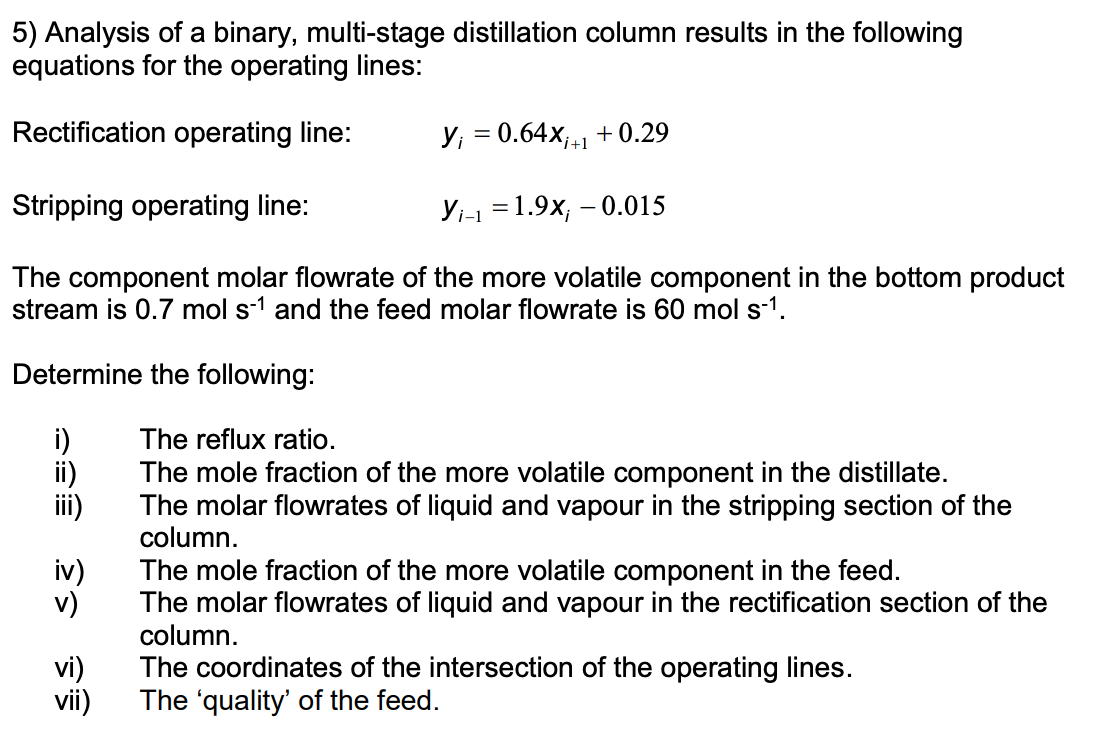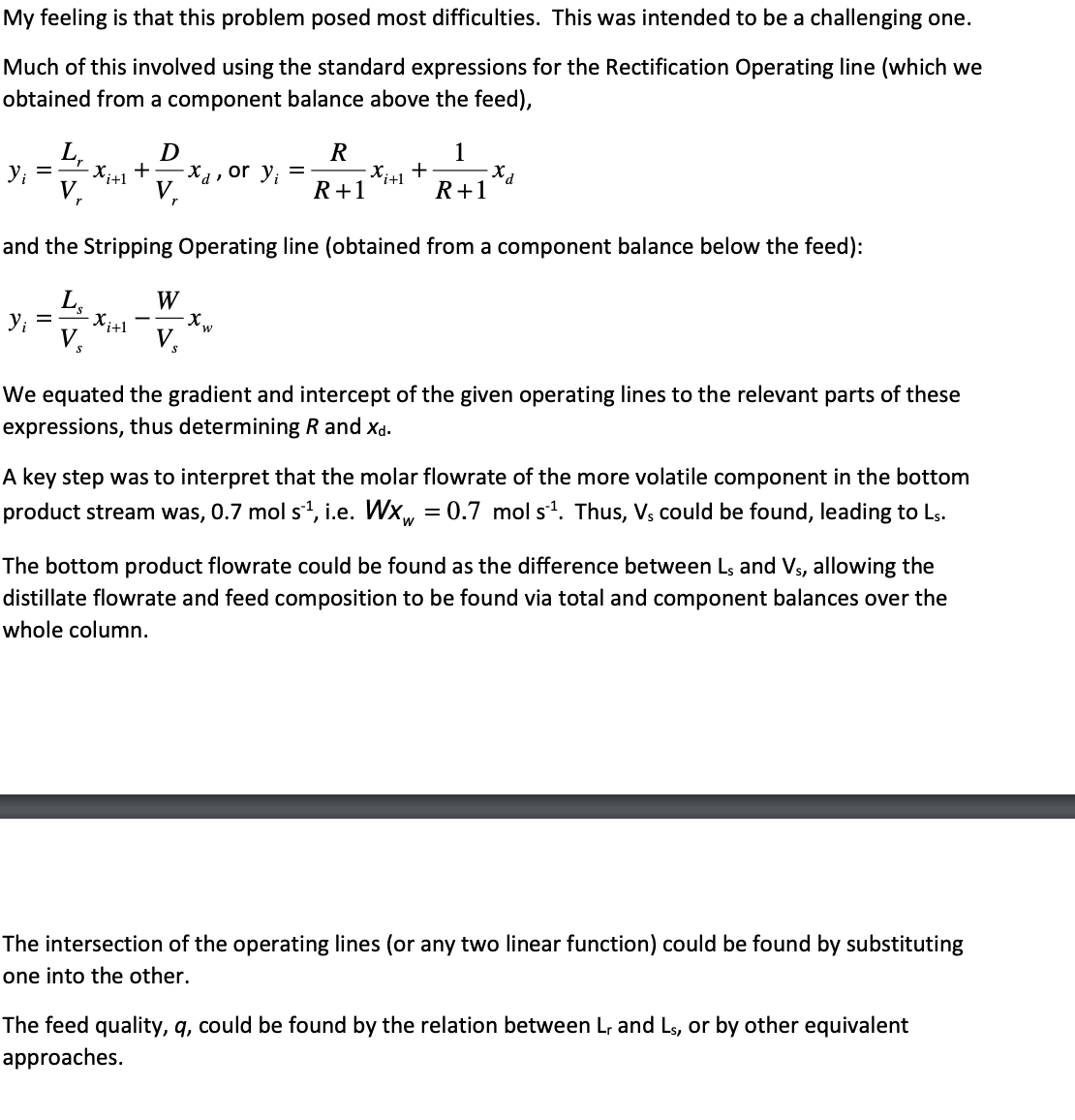5) Analysis of a binary, multi-stage distillation column results in the following equations for the operating lines: Rectification operating line: y₁ = 0.64x₁+1+0.29 Stripping operating line: Yi-1 = 1.9x; -0.015 The component molar flowrate of the more volatile component in the bottom product stream is 0.7 mol s1 and the feed molar flowrate is 60 mol s-1. Determine the following: = = iii) iv) v) The reflux ratio. The mole fraction of the more volatile component in the distillate. The molar flowrates of liquid and vapour in the stripping section of the column. The mole fraction of the more volatile component in the feed. The molar flowrates of liquid and vapour in the rectification section of the column. vi) The coordinates of the intersection of the operating lines. vii) The 'quality' of the feed.
5) Analysis of a binary, multi-stage distillation column results in the following equations for the operating lines: Rectification operating line: y₁ = 0.64x₁+1+0.29 Stripping operating line: Yi-1 = 1.9x; -0.015 The component molar flowrate of the more volatile component in the bottom product stream is 0.7 mol s1 and the feed molar flowrate is 60 mol s-1. Determine the following: = = iii) iv) v) The reflux ratio. The mole fraction of the more volatile component in the distillate. The molar flowrates of liquid and vapour in the stripping section of the column. The mole fraction of the more volatile component in the feed. The molar flowrates of liquid and vapour in the rectification section of the column. vi) The coordinates of the intersection of the operating lines. vii) The 'quality' of the feed.
Introduction to Chemical Engineering Thermodynamics
8th Edition
ISBN:9781259696527
Author:J.M. Smith Termodinamica en ingenieria quimica, Hendrick C Van Ness, Michael Abbott, Mark Swihart
Publisher:J.M. Smith Termodinamica en ingenieria quimica, Hendrick C Van Ness, Michael Abbott, Mark Swihart
Chapter1: Introduction
Section: Chapter Questions
Problem 1.1P
Related questions
Question
100%
Q5. i) R=1.78; ii)xd=0.81;; iii)Vs=46.7 mol/s; Ls=88.7 mol/s; iv) xf=0.25; vi)Vr=50 mol/s ,Lr=32 mol/s; v) x=0.242; y=0.445; vii)q=0.944
feed back to help with ques:

Transcribed Image Text:5) Analysis of a binary, multi-stage distillation column results in the following
equations for the operating lines:
Rectification operating line:
y₁ = 0.64x₁+1+0.29
Stripping operating line:
Yi-1 =1.9x; -0.015
The component molar flowrate of the more volatile component in the bottom product
stream is 0.7 mol s-1 and the feed molar flowrate is 60 mol s-¹.
Determine
the following:
The reflux ratio.
The mole fraction of the more volatile component in the distillate.
The molar flowrates of liquid and vapour in the stripping section of the
column.
リ
iv)
v)
vi)
vii)
The mole fraction of the more volatile component in the feed.
The molar flowrates of liquid and vapour in the rectification section of the
column.
The coordinates of the intersection of the operating lines.
The 'quality' of the feed.

Transcribed Image Text:My feeling is that this problem posed most difficulties. This was intended to be a challenging one.
Much of this involved using the standard expressions for the Rectification Operating line (which we
obtained from a component balance above the feed),
L₁
-Xitl
+
V₁ V₂
and the Stripping Operating line (obtained from a component balance below the feed):
Yi =
Y₁ = Xitl
V₂
D
W
V₂
xa,
-Xw
or yi
R
R+1
-Xitl
+
1
R+1
-Xa
We equated the gradient and intercept of the given operating lines to the relevant parts of these
expressions, thus determining R and Xd.
A key step was to interpret that the molar flowrate of the more volatile component in the bottom
product stream was, 0.7 mol s¹¹, i.e. Wxw = 0.7 mol s¹. Thus, Vs could be found, leading to Ls.
The bottom product flowrate could be found as the difference between Ls and Vs, allowing the
distillate flowrate and feed composition to be found via total and component balances over the
whole column.
The intersection of the operating lines (or any two linear function) could be found by substituting
one into the other.
The feed quality, q, could be found by the relation between Lr and Ls, or by other equivalent
approaches.
Expert Solution
This question has been solved!
Explore an expertly crafted, step-by-step solution for a thorough understanding of key concepts.
Step by step
Solved in 6 steps with 1 images

Recommended textbooks for you

Introduction to Chemical Engineering Thermodynami…
Chemical Engineering
ISBN:
9781259696527
Author:
J.M. Smith Termodinamica en ingenieria quimica, Hendrick C Van Ness, Michael Abbott, Mark Swihart
Publisher:
McGraw-Hill Education

Elementary Principles of Chemical Processes, Bind…
Chemical Engineering
ISBN:
9781118431221
Author:
Richard M. Felder, Ronald W. Rousseau, Lisa G. Bullard
Publisher:
WILEY

Elements of Chemical Reaction Engineering (5th Ed…
Chemical Engineering
ISBN:
9780133887518
Author:
H. Scott Fogler
Publisher:
Prentice Hall

Introduction to Chemical Engineering Thermodynami…
Chemical Engineering
ISBN:
9781259696527
Author:
J.M. Smith Termodinamica en ingenieria quimica, Hendrick C Van Ness, Michael Abbott, Mark Swihart
Publisher:
McGraw-Hill Education

Elementary Principles of Chemical Processes, Bind…
Chemical Engineering
ISBN:
9781118431221
Author:
Richard M. Felder, Ronald W. Rousseau, Lisa G. Bullard
Publisher:
WILEY

Elements of Chemical Reaction Engineering (5th Ed…
Chemical Engineering
ISBN:
9780133887518
Author:
H. Scott Fogler
Publisher:
Prentice Hall


Industrial Plastics: Theory and Applications
Chemical Engineering
ISBN:
9781285061238
Author:
Lokensgard, Erik
Publisher:
Delmar Cengage Learning

Unit Operations of Chemical Engineering
Chemical Engineering
ISBN:
9780072848236
Author:
Warren McCabe, Julian C. Smith, Peter Harriott
Publisher:
McGraw-Hill Companies, The